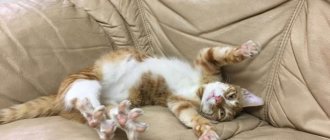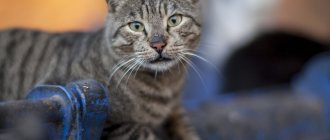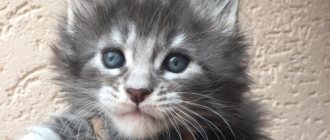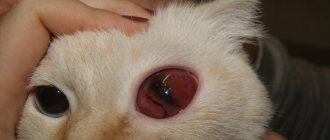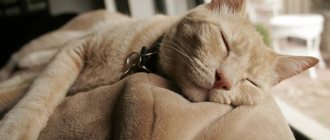5819Administration
Cats are able to evoke in their owners feelings comparable to love for small children. And, as in the case of children, you want to observe all their habits and study them in detail. Having become familiar with all the noticeable features of their beloved cat, many people have a question: does a cat have a belly button? After a thorough examination of the tummy, you may get the impression that it is not there. Therefore, there is a common misconception about the absence of a navel in mustachioed pets.
Physiological significance
It is reasonable to assume that all animals that are carried by a mother inside her body have a navel. After all, it is through the umbilical cord that the developing fetus receives through the placenta from the mother’s body all the necessary nutrients that are needed to support nascent life, build a new organism, its successful formation and development, and saturate the cells of the small lump with oxygen. This, accordingly, applies to cats.
A cat carries her kittens for about two months (sixty-five days to be exact). All this time, through the umbilical cord, the fetus receives everything it needs from the mother. During the birth process, after the birth of each kitten, their mother releases an afterbirth (this is the placenta). The cat independently bites the umbilical cord of all newborns. It is obvious that the umbilical cord, on the one hand attached to the placenta, on the other hand is attached directly to the kitten. This means that just like humans, cats have a navel, regardless of their breed.
Therefore, we can safely give a positive answer to the question of whether cats have a navel. How can you detect it in your cat?
Cat giving birth
So, you have decided to have fluffy feline offspring. It’s a little easier for cat owners - they invited the cat to “visit” for a couple of days, two months later they received kittens, and after another month and a half they chose the most beautiful and healthy one. But it’s not so difficult with cats either - nature has provided for everything. If your cat is noticeably rounder, arm yourself with the following knowledge.
It is necessary to prepare the box, cover it with a blanket, oilcloth and diaper, and also prepare additional diapers for a change.
In case the cat does not gnaw the umbilical cord or rupture the amniotic sac.
If you are going to help a cat, then you must do this with gloves.
How to understand that a cat is giving birth?
The cat becomes restless, hides and looks for a place for itself, even if it has long been accustomed to the box. She can follow her owner and meow invitingly. Examine the abdomen; before giving birth, the breasts fill with colostrum and become greatly enlarged. Notice if there are yellow or blood stains on the carpets or sofas - this is a sign that your water is breaking. As a rule, this happens a couple of hours before the birth itself, but it is possible right before it.
If you notice that the cat is tense and the abdominal muscles are contracting, then the process has begun. Transfer your pet to the box and pat its belly. If the attempts are rare, it means that the fetuses are only moving towards the uterus - this can last several hours. When the pushing becomes more frequent and longer, you can help the cat: place your palm so that when pushing, the cat rests on it with its hind legs. With your second hand, a little stronger than usual stroking, as if pushing the kittens from the chest to the tail.
Kittens come out head first. Sometimes they may be in the bubble they were in in the "mother's" belly. The cat bursts the bladder, gnaws the umbilical cord, and after a couple of minutes the placenta comes out. Kittens are born 30 minutes to an hour apart. If the delay is longer, then one of the complications could occur:
If the attempts become more frequent and continue for more than 3-4 hours, but the cat does not give birth, perhaps they are too weak to push the kitten through. Call a veterinarian, and if this is not possible, give an intramuscular injection of oxytocin (1 ml, no more, and only on the advice of a doctor). This will increase the effort and speed up labor.
Examine the bubble carefully: if the kitten is in it sideways rather than head first, lubricate your fingers with Vaseline and gently push it back. During the next attempts he will turn over.
The cat does not rupture the amniotic sac
The kitten came out, but the cat does not burst the bubble, do it yourself with sterile scissors as quickly as possible, and make sure that the kitten breathes and meows.
The cat does not chew the umbilical cord
If after birth, the cat does not pay attention to the baby, you will have to do everything yourself: tie the umbilical cord 4 cm above the base and cut it. Dry it with a towel and apply it to your mother's breast.
The kitten's head appears, but the cat cannot push it further. It is necessary to help because it can be suffocated by muscle contraction. Lubricate your fingers with Vaseline and insert into the birth canal, gently rotating your finger around the kitten's head, this will relax the vagina. Or feel the front paws, hook the “baby” under them, and very slowly and carefully, pull him towards you with each contraction, but not up or down, but parallel to the floor, so as not to damage the vagina.
The main thing is not to be afraid of anything and act decisively. More often, kittens die during childbirth if we are inactive, afraid to provide help, and not because of our intervention.
Genera of Scottish fold and straight-eared cats.
If the mating is successful, the Scottish cat becomes pregnant and signs of this can be detected at 3-5 weeks. The nipples turn pink and swell. The cat eats and sleeps more. And in the period from 56 to 71 days you need to wait for birth. The birthing area must be prepared in advance so that the cat gets used to it. This could be a box or drawer of such a size that she can comfortably fit in with her kittens. However, despite the pre-prepared place, the cat may worry a few days before giving birth, looking for a place that is more suitable in her opinion for the nest. At the same time, she tries to climb into the closets, into the sofas, into the bed. You can try to block access to these places and accustom her to the place you have prepared, but sometimes this does not work. And sometimes I had to agree with the cat and place her nest where she wanted (for example, on the bottom shelf in the closet).
About 5 days before the expected birth, you should start measuring the temperature of the expectant mother. On the day of birth, a rectal measurement shows a decrease in temperature to 36.7 C (normal temperature for cats is 38.3 C - 38.9 C). In the first phase, the cat begins to have contractions, her breathing and pulse quicken, she rushes about, often changing position. This period can last from 12 to 24 hours. If more, you need to contact your veterinarian. In the next phase of labor contractions, strong pushing begins, which simultaneously sets in motion the muscles of the abdomen and diaphragm and pushes the fetus into the vaginal canal. In this case, a small amount of liquid may be released. At the vaginal exit, part of the amniotic sac covering the kitten is shown. At this time, the cat lies on its stomach or side; if the fetus is large, then it stands and squats on its hind legs. From the moment when the kitten’s head appears at the exit of the birth canal until its full appearance, approximately a quarter of an hour passes. If there is a delay, you should urgently call a doctor. In classic presentation, the kitten is positioned with its head and front paws facing the exit. But almost very often kittens walk with their hind legs, which is also considered normal and, if the bladder does not burst, does not lead to complications in childbirth. As soon as the kitten is born, it is necessary to immediately release it from the amniotic sac. Usually the cat independently treats the baby, gnawing the membranes, intensely licking the kitten's face, cleaning its nose, mouth and body, thereby stimulating its breathing and blood circulation, causing the first separation of feces, after which it gnaws the umbilical cord. The kitten takes a sharp breath, its lungs expand, and it begins to breathe. Sometimes inexperienced or shy cats don't do this. Then you need to help her break the bubble on his face, wipe his face and body with a clean napkin. If the cat has not chewed the umbilical cord, it must be cut with scissors at a distance of about 2 cm from the abdomen, the end of the umbilical cord should be grasped with two fingers and treated with an antiseptic. After this, the kitten should again be offered to its mother for further licking. The umbilical cord should not be cut until the afterbirth has come out. The placenta (baby place, placenta) must come out after each kitten. Cats usually eat them, but eating too many placentas can cause diarrhea, so it's best not to let your cat eat more than 2 placentas. It is imperative to ensure that the number of placenta is equal to the number of kittens born. A failed placenta may appear after a few hours, but if this does not happen, give one injection of oxytocin - 0.2 ml. If this does not help, you need to contact a veterinarian. The remaining afterbirth inside the cat will decompose. The cat rests for some time after the birth of a kitten, then contractions and pushing resume, and the next kittens are born. Between the birth of subsequent kittens, it takes from 15 minutes to 2-3 hours. At the end of the birth, the cat finally calms down and feeds her kittens. She needs to be given a clean bedding and left alone. In the future, you need to make sure that she licks the kittens well, that they are clean and eat well.
No comments yet!
Featured Articles
Hair coming out after childbirth what to do
Girls, after childbirth your hair falls out a lot! What should I do? Yes, yes, I have further.
Where to look for a cat's belly button?
It’s not enough to theoretically consider the question of whether cats have a navel; you should certainly make sure in practice that your pet has one. It is important to remember that a cat's belly button is different from a human's. And this is logical, because we belong to different species, therefore, most of the signs in humans and cats are strikingly different. That is why you should not try to find a depression on your cat’s body that is identical to a human one. No, you need to find out where a cat’s belly button is in a completely different way.
The navel is located on a cat's stomach, similar to the location of a human. No hair grows where a cat's belly button should be. But finding what you are looking for the first time can still be problematic, because it can be covered with the fur that surrounds it. Although the appearance of the navel may vary between cats, depending on their size, breed and age, the navel is predominantly a small round or oval area of belly skin, not covered with hair, which is located between the animal's two lower nipples.
Depending on the cat's breed and the quality of its fur, detecting the belly button may be easier or more difficult. The longer a cat's fur, the more difficult it is to detect. Conversely, it is very easy to find the navel in short-haired or even completely hairless cats. If you look carefully, the navel cannot be confused with a nipple or with any other neoplasms.
Is your cat giving birth? Here's what to do!
If your cat goes into labor, rely on her maternal instincts. Just stay close to her and watch what happens. Only act and take action if something goes wrong.
First, make sure everything is ready for your cat to give birth. Two weeks before the expected due date, you should place a large box in an area of your home that your pregnant cat frequents. Your cat wants to have a cozy nest for her babies. Make sure the room the box is in is warm. Place paper or other material in the box that your cat can easily tear and shred. A giving birth cat will be quite happy with the paper. A blanket will also come in handy during childbirth. Other essentials include towels, clean scissors, styptics, clean thread, and antiseptic.
Keep all doors closed. Your cat should not give birth on the street!
Labor should begin no earlier than after 61 days of the cat's pregnancy. Otherwise, there is a high probability that the kittens will not survive. But if labor does not begin after 70 days, contact your veterinarian immediately.
During the last days of your cat's pregnancy, you must monitor her and her condition very carefully and closely. Here are some signs that indicate labor is about to begin:
- Temperature drop by 1° C. Normal temperature is 38.6° C.
- Restless behavior. Your cat is looking for a place to give birth.
- The appearance of milk from the nipples. Most cats have eight nipples.
Once labor begins, your cat begins to purr and breathe heavily rhythmically. Labor has begun, but it is possible that the first kitten will appear only in a few hours. The contractions will intensify. Calm your cat down, tell her kind, gentle words. It is normal for fluid and blood to start coming out of her vulva. If your cat has been having strong contractions for two hours without any signs of kittens, you should contact your veterinarian immediately! Perhaps two kittens ended up in the birth canal together and blocked the path for themselves and the others.
Eventually, the first kitten is delivered enclosed in a bag filled with liquid. The sac may burst while the kitten is emerging from the birth canal. The mother will begin to lick the kitten. Soon the newborn will breathe normally and cry for the first time, just like a human baby.
Typically, a cat chews the umbilical cord with its teeth. Only if she does not do this can you carefully cut the umbilical cord with scissors. In this case, be sure to tie the umbilical cord with a clean thread at a distance of 4 cm from the kitten’s belly and cut it off above the tied area. Lubricate the incision with an antiseptic (for example, alcohol). It is very important to do everything correctly so as not to endanger the kitten’s life. This is just one of the many things that can go wrong during childbirth. Therefore, it is extremely important that you prepare well for them.
The placenta appears immediately after the kitten is born or shortly thereafter. Most often, the cat eats it. Placentas should follow the birth of each kitten. A placenta that does not come out after delivery can cause serious infections.
When the kitten is breathing well and has been licked clean by the cat, place it close to the cat's nipple. Usually he starts sucking milk right away.
Your cat won't get into trouble during and after birth if you know exactly how to recognize complications and what to do about them. If you suspect something is wrong, call your veterinarian immediately if you don’t want to lose your cat and kittens.
You can also read about childbirth in a cat here.
Why do misunderstandings arise?
Often caring, but overly emotional cat owners mistake the cat's navel for symptoms of some disease, for example, lichen or scabies. Unnecessary visits to the veterinarian become a serious stress for both the animal and its owner. Therefore, it is important to know whether cats have a belly button, to be able to find it on your pet’s body, and not to confuse it with really serious manifestations.
Be attentive to your pets, take care of them properly, and then their sincere, selfless gratitude will not take long to arrive. The more attention given to pets, the happier they become and the more joy they bring to their owners. Don't be afraid to be curious and learn more about your pets!
What to do if the cat did not chew the kitten's umbilical cord
Please tell us how many centimeters YOU leave and why!
common options:
— . The umbilical cord is cut as follows: the kitten is placed on its back or side and with two fingers, the blood in the umbilical cord is “squeezed” towards the stomach; at a distance of about 2-3 cm from the kitten’s stomach, you clamp the umbilical cord with your nails. In some cases, the umbilical cord can be tied with sterile silk thread or catgut (to prevent bleeding); it is recommended to trim it with sterile, not very sharp scissors at a section that is closer to the placenta. After this, the navel is cauterized with an iodine solution, and the treated kitten is placed next to the mother so that she can lick it.
— It is important to ensure that the cat does not gnaw the umbilical cord too close (no closer than 2.5 cm) to the kitten’s stomach, otherwise it may develop an umbilical hernia and bleeding. The cat rubs the umbilical cord in such a way that the blood vessels are stretched and partially twisted. Thanks to this, bleeding does not occur.
From last year's and previous experience, we believe
which is optimal and completely safe,
in terms of complications with the navel, the length is 7 - 9 cm.
A year ago I wanted to leave Sarah
8 cm, but either the hand trembled,
Either the umbilical cord has stretched, in general there is about 6 cm left.
And after a few hours (closer to the morning) the umbilical cord shrunk to somewhere around 1.5 - 2 cm! ! !
And the next day it dried out and became about 1 cm.
We were very worried about a hernia or something else that hadn’t happened with the navel!
What will happen to the shorter (initially) umbilical cord the next day? ? ?
So the minimum size of the umbilical cord should be at least 6 cm!
Of course, the degree of drying of the umbilical cord in kittens is a very individual question,
For some, a shorter length may be enough, but our answer is: 8 - 9 cm.
It doesn't make any sense anymore
and less is fraught with possible “umbilical” problems.
Let it be longer and dangle. It will dry out and fall anyway.
But your soul will be at peace. This time, if you need help
for our Big Cat, the length of the kitten’s navel will be 7 – 9 cm.
Useful materials:
- Cutaneous horn General description of the disease Cutaneous horn on the forehead or face (ICD 10 code - L57.0) -...
- Itching and odorless discharge Main causesBefore considering the factors that provoke the appearance of discharge that has a sour odor, it is necessary to immediately note...
- Normal temperature in animals Normal temperature in different types of animals Veterinary services Day hospital for animals Veterinary certificates Vaccination…
- Discharge in women What kind of discharge between menstruation is considered normal? Female discharge normally consists of mucus from the cervical canal, dead...
Where is
Some people cannot find where a cat's belly button is. This is due to the fact that it has nothing in common with a person’s navel. Externally it is a small scar. In small kittens it may be pink and more noticeable, but over time it fades and becomes tiny. In addition, the body of animals is covered with hair, under the layer of which it is difficult to notice scars on the skin.
To find where a cat’s belly button is, follow these simple steps:
- Place the animal on its back.
- Carefully examine the abdomen, paying attention to the lower part.
- The small, pale, hairless area will be the navel. In cats it is located between the lower nipples.
It is easier to find scars on pets without fur. Since hair does not grow on the mark of the umbilical cord, if it is accidentally discovered, the owners confuse the navel with lichen or other dermatological diseases.
Usually the scar does not cause any inconvenience to its owner and only serves as a reminder of the intrauterine connection with the maternal body. In rare cases, it may change its shape, size or color. If you notice changes, do not delay visiting your doctor, as they may be a sign of the development of an umbilical hernia or other disease.
